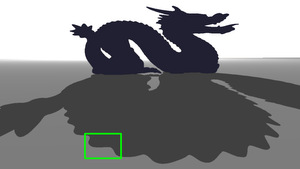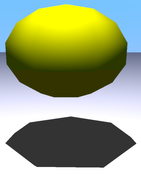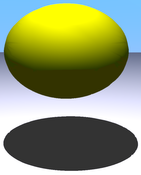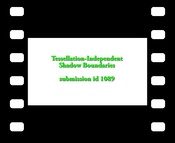Information
- Publication Type: Journal Paper with Conference Talk
- Workgroup(s)/Project(s):
- Date: June 2012
- Journal: Computer Graphics Forum
- Volume: 4
- Number: 31
- Lecturer: Oliver Mattausch
- ISSN: 1467-8659
- Event: EUROGRAPHICS Symposium on Rendering 2012
- Conference date: 27. June 2012 – 29. June 2012
- Pages: 1465 – 1470
- Keywords: real-time rendering, shadows
Abstract
We propose an efficient and light-weight solution for rendering smooth shadow boundaries that do not reveal the tessellation of the shadow-casting geometry. Our algorithm reconstructs the smooth contours of the underlying mesh and then extrudes shadow volumes from the smooth silhouettes to render the shadows. For this purpose we propose an improved silhouette reconstruction using the vertex normals of the underlying smooth mesh. Then our method subdivides the silhouette loops until the contours are sufficiently smooth and project to smooth shadow boundaries. This approach decouples the shadow smoothness from the tessellation of the geometry and can be used to maintain equally high shadow quality for multiple LOD levels. It causes only a minimal change to the fill rate, which is the well-known bottleneck of shadow volumes, and hence has only small overhead.Additional Files and Images
Additional images and videos
Additional files
Weblinks
BibTeX
@article{MATTAUSCH-2012-TIS,
title = "Tessellation-Independent Smooth Shadow Boundaries",
author = "Oliver Mattausch and Daniel Scherzer and Michael Wimmer and
Takeo Igarashi",
year = "2012",
abstract = "We propose an efficient and light-weight solution for
rendering smooth shadow boundaries that do not reveal the
tessellation of the shadow-casting geometry. Our algorithm
reconstructs the smooth contours of the underlying mesh and
then extrudes shadow volumes from the smooth silhouettes to
render the shadows. For this purpose we propose an improved
silhouette reconstruction using the vertex normals of the
underlying smooth mesh. Then our method subdivides the
silhouette loops until the contours are sufficiently smooth
and project to smooth shadow boundaries. This approach
decouples the shadow smoothness from the tessellation of the
geometry and can be used to maintain equally high shadow
quality for multiple LOD levels. It causes only a minimal
change to the fill rate, which is the well-known bottleneck
of shadow volumes, and hence has only small overhead. ",
month = jun,
journal = "Computer Graphics Forum",
volume = "4",
number = "31",
issn = "1467-8659",
pages = "1465--1470",
keywords = "real-time rendering, shadows",
URL = "https://www.cg.tuwien.ac.at/research/publications/2012/MATTAUSCH-2012-TIS/",
}


 draft
draft



